I can measure my life in sewing machines.
[‘Sewing’ (1913), Hans Heysen]
I’ve had five in all, starting with my Nana’s old Singer; it was originally turned by hand, but my Mum had it converted to electricity when I was nine or so, and I was off. I loved the classic Singer shape and the ornate black-and-gold patterns and lettering, and it made me feel incredibly accomplished when I turned out Winnie-the-Pooh stuffed toys (McCall’s pattern 8087 (1968) now in the V&A, no less - or £50 on eBay) made from Stockport Market’s finest corduroy.
The next machine was a joint Christmas present with my sister, who never got a look in as I whisked it off to university, Germany, Belgium, and Windsor (sorry, Kate). Later, I got a nice, straightforward Brother for a birthday. A well-known machine embroiderer was very rude about it when I went to one of her workshops. At the end she said sniffily, '‘that machine hasn’t given you much bother, really, has it?. Everyone else had all-singing, all-dancing machines (like hers) and I felt, in today’s parlance, machine-shamed.
[Linda Miller]
Not long after, I went to a machine embroidery weekend with Linda Miller who would never, ever say anything like that, but I did realise that I needed something that would stand up to a real bashing in order to produce the embroideries I wanted to make. I was very lucky to find a secondhand unused 1970s Bernina which went forwards, backwards and, to show off, it did zig-zags. It was a horrible 70s mustardy colour, heavy, sturdy, and brilliant. It has lasted a long time, and Phoebe is the new custodian. Because I now have the best machine for what I want to do; it’s another Bernina, again nothing fancy, but it will ‘see me out’ as my mother-in-law used to say about her coat and settee (a realistic but rather morbid turn of phrase which makes me laugh now that I am the age I am).
I have always loved my sewing machines in a way that’s different to how I feel about other useful, inanimate, domestic objects. I love my pink settee (not that I’m ready to say it’ll see me out, though, as ideally I’d like time to go through several more brightly coloured pieces of furniture), my coffee machine, my bath, my mixer. But my sewing machine is different, it’s an extension of me, and I’m very protective of if. I find it amazing that it can mirror my mood; when I am tired or frustrated with a pattern, it somehow knows and seizes up or the needle breaks or the bobbin gets stuck.
It’s amazing to think of all the other millions of domestic sewing machines in homes around the world and how highly valued they are by their owners. A sewing machine is often a part of the family, it bestows a level of independence, can generate earnings, and enable creativity with the ability to make curtains, clothes, stuffed toys, books, quilts, pieces of art. Yet, given their ubiquity, there’s relatively very little art or film or literature centred around the domestic sewing machine. Could this possibly be anything to do with the fact that it’s mostly women who use them in the home, and that they are associated with female workforces in mills, I wonder.
Images like this don’t exactly help - or challenge stereotypes. This is Tony Bennett in a 1966 advert; the whole thing is weirdly cream-meets-beige-meets magnolia and he appears to be just casually leaning over the back of a chair and maybe not even in the same room as the machine. Of course the manufacturers decided we needed a man to advertise sewing machines, in the same way we couldn’t possibly have chosen our own soap powder or washing-up liquid without it having a man’s approval.
This is more the kind I thing I want to see: John Lennon - probably a little earlier than the Tony Bennett ad, maybe 1965 - looking like he knows his way round a sewing machine. Interestingly, Help! (made in 1965) has a credit at the end which reads, “This film is respectfully dedicated to the memory of Mr. Elias Howe, who, in 1846, invented the sewing machine.” No-one is sure why, but I like to think the Beatles were just immensely curious, down-to-earth, funny, and wide-ranging in their cultural references. Plus, they grew up in Liverpool, the city of matriarchs
It’s interesting that are disappointingly very few paintings of women sitting and working at sewing machines (I mean in domestic settings, not workplaces), although there are trillions of images of needlewomen sewing by hand, head down, held-in, quiet, poised, demure. By contrast a sewing machine is almost industrial, it takes up room, makes a noise, goes fast, requires technical skills, maybe even a screwdriver, oil, and rags, isn’t dainty, and doesn’t always make a lovely composition.
[‘Woman with a Sewing Machine’ (1954), David Hockney, Tate]
Hockney’s lithograph is an excellent exception. The huge black machine is not going to faze her, she’s in charge, and looks at it almost affectionately. Maybe she made her smart outfit on it?
There is also a snobbery thing at work, here. When sewing machines were becoming widely available, better-off women like some of the draper’s customers in High Wages were able to have a ‘little woman’ who made or altered their clothes. Less well-off women made their own clothes and, after the advent of ready-made garments as sold by Jane in the novel, this was regarded as either economic necessity or eccentricity (eg the Marwood sisters in The Priory).
[Edith Head and Her Miniature Sewing Machine Collection (1977), Robert Cumming, Whitney collection]
Even female designers might have deliberately avoided using or being associated with sewing machines. The brilliant Edith Head had a huge collection of miniature machines which wouldn’t exactly stand up to anything bigger than a doll’s dress. “Head designed on mannequins…pinned and draped but didn't sew…She could do hand stitching but, although she had a collection of sewing machines, could not work on a machine.” (Washington Post, obit. 1981). It makes you wonder if she pretended to not be able to sew so that she didn’t end up in a backroom
There’s something else about private, domestic skills being taken over and performed in public by men thus edging women out of the picture. As with cooking, the ability to sew on a machine often has to be made ultra-masculine. This was taken in 1942 by Cecil Beaton, whose war photos are amazing: a sailor on board HMS Alcantara using a portable sewing machine to repair a signal flag during a voyage to Sierra Leone. Just look at the muscles and macho required to use a sewing machine properly. Edith Head couldn’t do this.
[‘On the Veranda’ (1958), Aleksei Gritsai]
So let’s get back to domestic machines, and the way they evoke a sense of comfort, cosiness and continuity. In Simenon’s novel, Maigret, whose working life reveals the underbelly of society and awful living conditions, prefers to use the less formal salle à manger, and not the salon, in his Parisian flat: "C'était là que Maigret avait ses pipes, son fauteuil, Mme Maigret sa machine à coudre”/It was here that Maigret had his pipe, his armchair, and Mme Maigret had her sewing machine (Le Revolver de Maigret, 1952). All emblems of comfortable, ordinary, unexciting domesticity. The sewing machine falls into the category of things kept in a snug back room, not a posh parlour, whirring in background, a sign someone is at home, something is being made, rather like coming home to the smell of tea being cooked. Even the vocabulary is nicely old-fashioned sounding with like paper patterns, pinking shears, and bobbins.
[Just off the machine after adding the binding - the back of embroidered cloths quilt. It’s been a long time since I’ve loved a fabric so much. Philips Jacobs, of course.]
A sewing machine has been by my side for decades now. I have gone from making stuffed toys to 1970s smock tops, from curtains to mending Tom’s trousers and rugby shirts, from machine embroidery to quilts and dressmaking. Mine stays out all the time. Like many people, I prefer to know it’s waiting for me, ready when I am. My machine matters.
Happy sewing, happy Sunday!
PS A sewing machine is a big investment, I know, and one that is no doubt way down the list of priorities for many people, especially at the moment. Oh, to be able to use a machine provided for free in a public library in an enlightened country such as Finland.

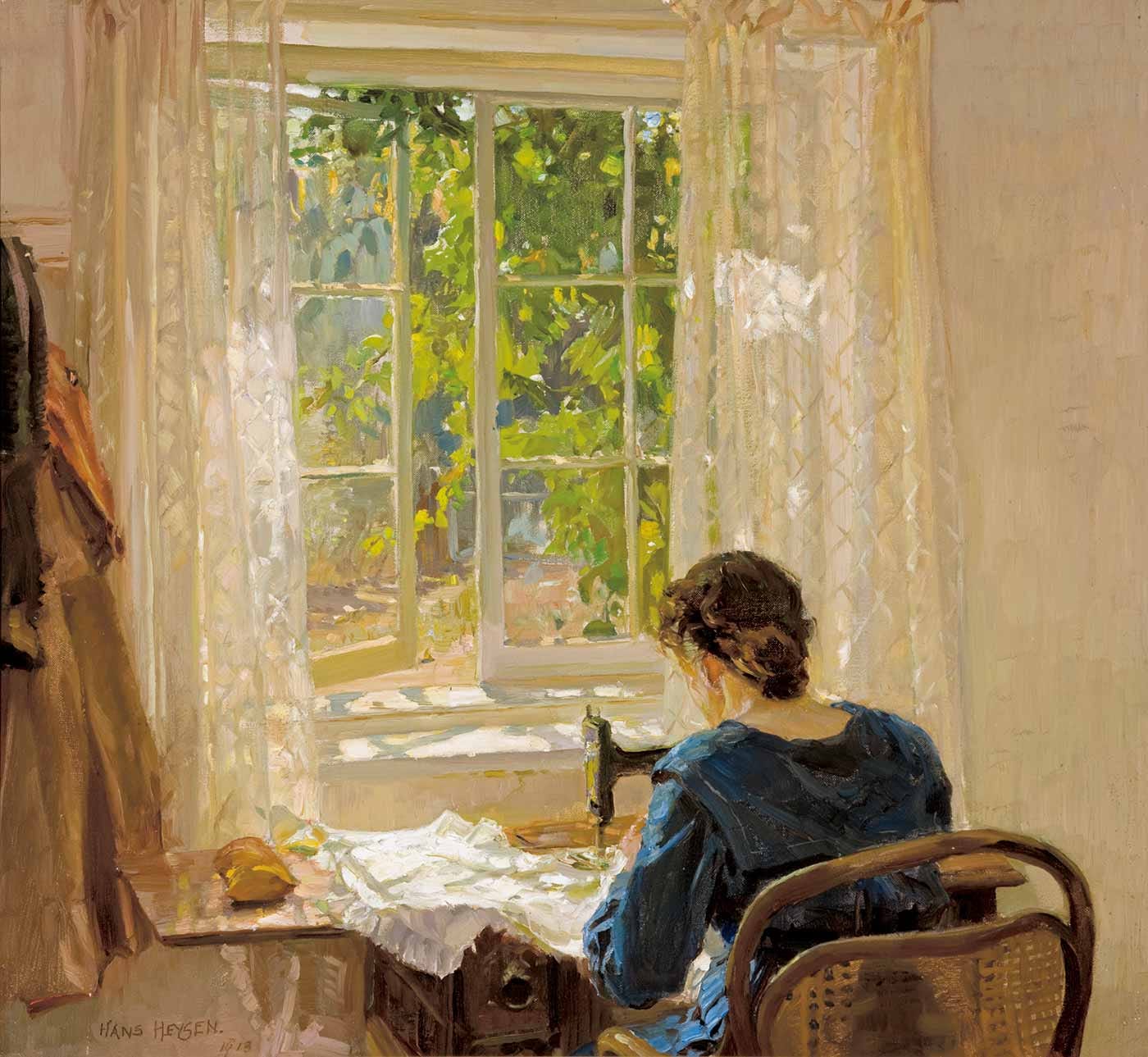

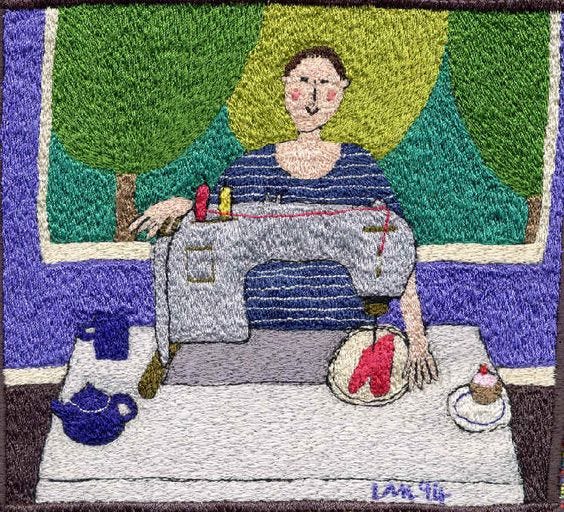
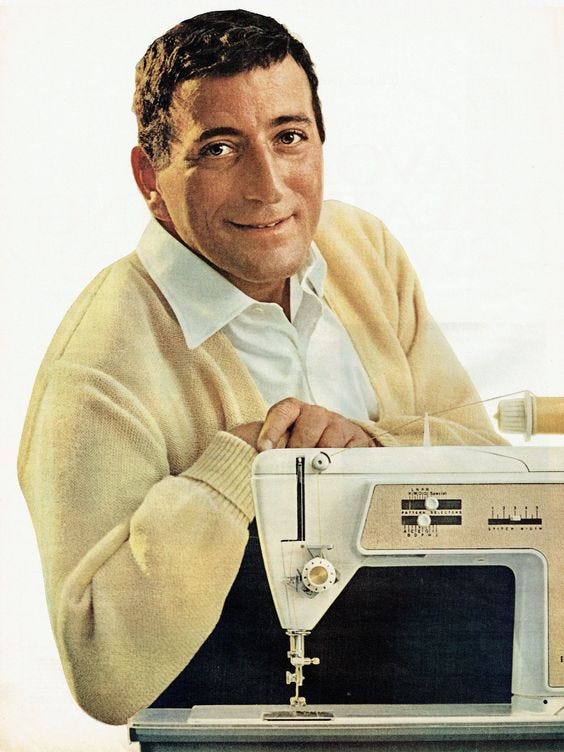
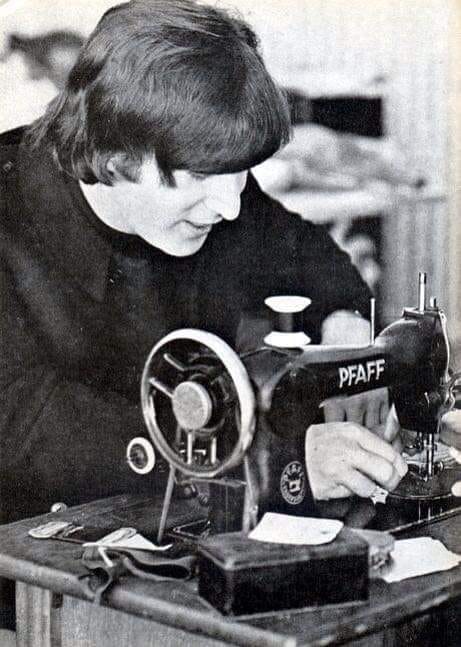

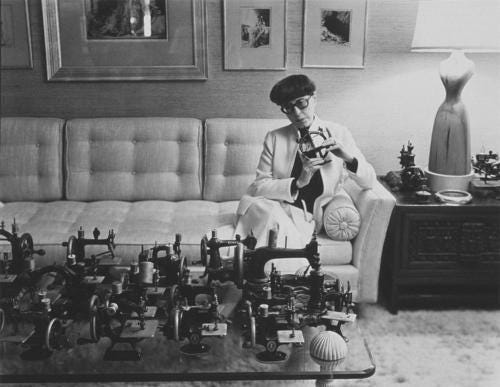
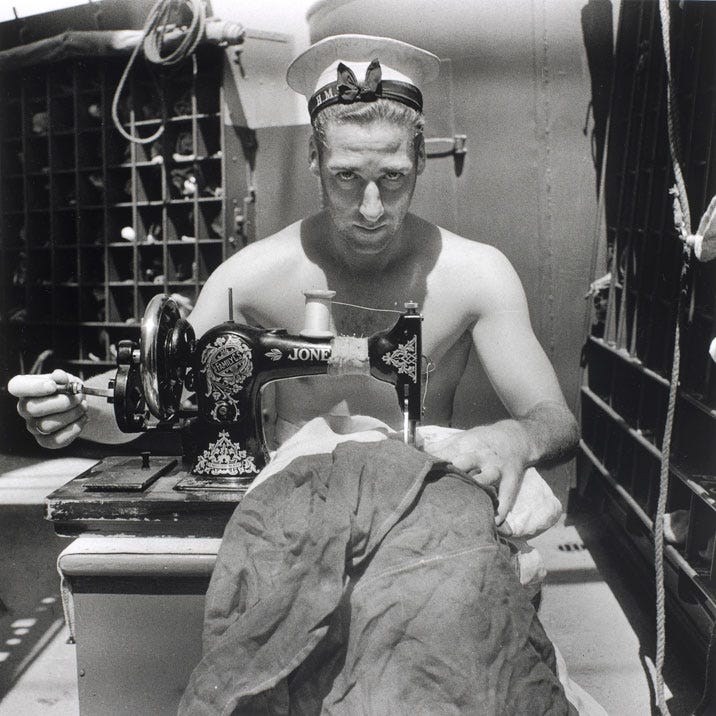
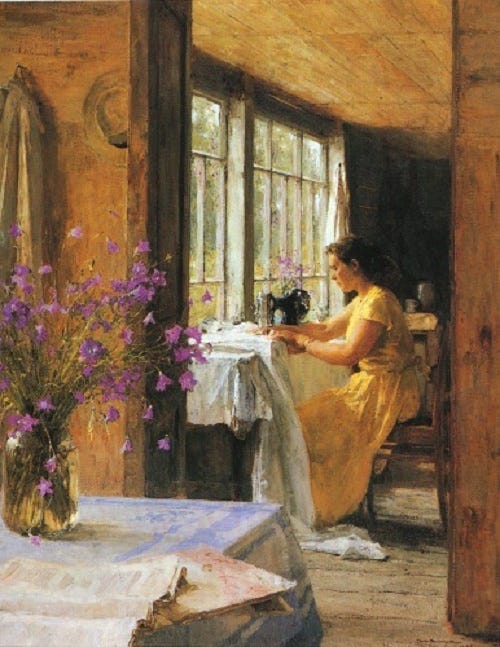

Sewing machines have always been the pinnacle of domesticity in my world. I sewed for four children in a 1950s New Home making them clothes and all the things from stuffed critters to curtains to quilts. All set up on the upstairs landing of our old farm house. Nowadays, I have a room of my own that holds my most treasured Featherweight (born the same year I was -- Kizmet!), the New Home, Singer treadle, Singer 401, and my MIL Niche. I, too, was shamed at a quilting retreat many years ago by a well known designer who laughed at my wee Featherweight. I packed my darling up at lunch and we left. Who wants to associate with a machine snob? My ladies stay out waiting their assigned tasks. Each has a specialty and lines are never crossed. The Featherweight would NEVER sew on a binding and the treadle understands she is for the times when I need to slow down and ponder. I hope all mine will "see me out" as I have far more circles around the sun behind me than I will ever have ahead. The greatest joy has been my seven year old granddaughter has requested (actually demanded) that I bring a machine and teach her to make a quilt when I stay with her this fall. I'm confident my ladies will find a loving home with her. And the torch, er, machine, shall pass to the next generation.....
I had to respond to your lovely piece of writing. At nearly 70 years of age I have recently bought myself a brand new Singer sewing machine. I started sewing clothes for my Sindy doll beside my mother while she made her and my dresses from lovely fabrics bought in Kingston on Thames market. Then my grandmother passed on her old Singer machine to me as a student. Later I inherited my Mother in Law’s 1980’s Singer which lasted me until recently. It still worked but was getting really difficult! I gave it away and bought my first new machine- a joy! I could never imagine not having and using a sewing machine. They provide so much independence from the pressure to buy ‘stuff’. Thank you for such inspiration and interesting articles, my sewing friend and ‘soul sister’ recommended your blog.